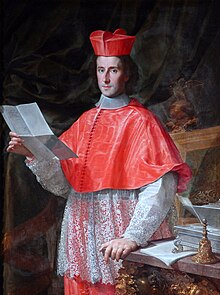
Back الكاردينال-ابن أخ Arabic Cardenal-nebot Catalan Kardinalnepot German Kardinalo Nepo Esperanto Cardenal nepote Spanish Kardinal nepote Basque Kardinaalinepos Finnish Cardinal-neveu French Kardinal kerabat ID Cardinal nipote Italian

A cardinal-nephew (Latin: cardinalis nepos;[1] Italian: cardinale nipote;[2] Spanish: valido de su tío; Portuguese: cardeal-sobrinho; French: prince de fortune)[3] was a cardinal elevated by a pope who was that cardinal's relative. The practice of creating cardinal-nephews originated in the Middle Ages, and reached its apex during the 16th and 17th centuries. The last cardinal-nephew was named in 1689 and the practice was abolished in 1692.[4] The word nepotism originally referred specifically to this practice, when it appeared in the English language about 1669.[5] From the middle of the Avignon Papacy (1309–1377) until Pope Innocent XII's anti-nepotism bull (a papal charter), Romanum decet pontificem (1692), a pope without a cardinal-nephew was the exception to the rule.[6] Every Renaissance pope who created cardinals appointed a relative to the College of Cardinals, and the nephew was the most common choice,[7] although one of Alexander VI's creations was his own son.
The institution of the cardinal-nephew evolved over seven centuries, tracking developments in the history of the papacy and the styles of individual popes. From 1566 until 1692, a cardinal-nephew held the curial office of the Superintendent of the Ecclesiastical State, known as the Cardinal Nephew, and thus the terms are sometimes used interchangeably. The curial office of the Cardinal Nephew as well as the institution of the cardinal-nephew declined as the power of the Cardinal Secretary of State increased and the temporal power of popes decreased in the 17th and 18th centuries.
The list of cardinal-nephews includes at least fifteen, and possibly as many as nineteen popes[8] (Gregory IX, Alexander IV, Adrian V, Gregory XI, Boniface IX, Innocent VII, Eugene IV, Paul II, Alexander VI, Pius III, Julius II, Leo X, Clement VII, Benedict XIII, and Pius VII; perhaps also John XIX and Benedict IX, if they were really promoted cardinals; as well as Innocent III and Benedict XII, if in fact they were related to their elevators); one antipope (John XXIII); and two or three saints (Charles Borromeo, Guarinus of Palestrina, and perhaps Anselm of Lucca, if he was really a cardinal).
- ^ Cardinale, Hyginus Eugene. 1976. The Holy See and the International Order. Maclean-Hunter Press. p. 133.
- ^ Burckhardt, Jacob, and Middlemore, Samuel George Chetwynd. 1892. The Civilisation of the Renaissance in Italy. Sonnenschein. p. 107.
- ^ Signorotto and Visceglia, 2002, p. 114. Modern French scholarly literature uses the term "cardinal-neveu".
- ^ Bunson, Matthew. 1995. "Cardinal Nephew". The Pope Encyclopedia. Crown Trade Paperbacks. ISBN 0-517-88256-6.
- ^ Oxford English Dictionary has, as its first citation, Pepys' writing about a family reading of Gregorio Leti's Il Nipotismo di Roma, or, The History of the Popes Nephews: from the time of Sixtus IV, anno 1471, to the death of the late Pope Alexander VII, anno 1667. September 2003. "Nepotism"
- ^ Until Innocent XII, the only other exceptions were popes who did not appoint cardinals: Pius III, Marcellus II, Urban VII, Leo XI) and Adrian VI (who appointed one cardinal).
- ^ Vidmar, John. 2005. The Catholic Church Through The Ages: A History. Paulist Press. ISBN 0-8091-4234-1. p. 170. Vidmar gives the exception of Nicholas V, who elevated his half-brother Filippo Calandrini on December 20, 1448 (see: Salvator, 1998, "15th Century (1404–1503)").
- ^ S. Miranda: Consistory of 1127, citing some older authors such as Alphonsus Ciacconius, says that Pope Anastasius IV (Corrado della Suburra) was probably a nephew of his elevator Honorius II; however, modern scholars (Brixius, p. 36 and 78; Klewitz, p. 128; Hüls, p. 128 and 201; Zenker, pp. 46–48) are in agreement that Corrado was created cardinal by Paschalis II, and deny or do not mention his relationship with Honorius II.
© MMXXIII Rich X Search. We shall prevail. All rights reserved. Rich X Search